
X-Ray Fashion Virtual Reality (VR) Experience to be premiered in official selection at the Venice Film Festival.

X-Ray Fashion Virtual Reality (VR) Experience to be premiered in official selection at the Venice Film Festival.

HLPF side event
10 July 2018 1:15-2:30 PM
Conference Room 4
Connect4Climate's Senior Advisor Francis James Dobbs was part of a discussion on what a UN Alliance on Sustainable Fashion could look like and introduced the X-Ray Fashion VR experience as one of the ways that Connect4Climate could contribute to an ongoing coalition working to make the fashion industry more sustainable.
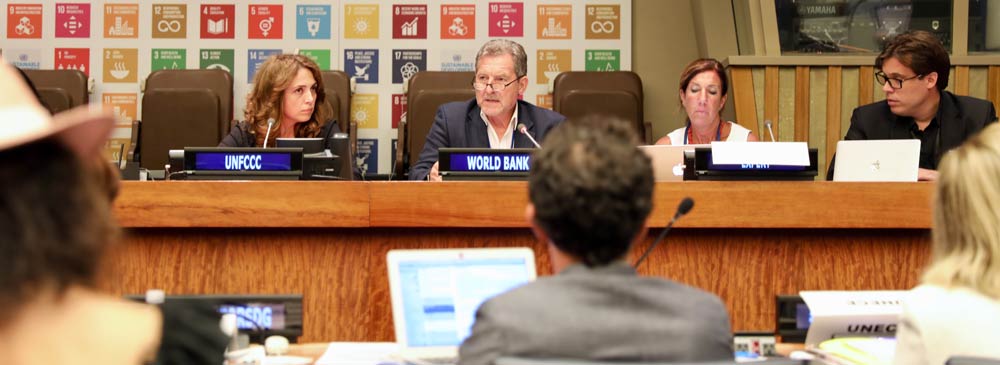
Francis James Dobbs, Senior Advisor, Connect4Climate, Global Engagement and Partnerships, World Bank Group. Photo Credit: Benjamin Steinlechner / Connect4Climate
Fashion is an environmental and social emergency. Nearly 20 percent of global wastewater is produced by the fashion industry, which also emits about ten percent of the global carbon emissions - more than the emissions of all international flights and maritime shipping combined. Cotton farming is responsible for 24 percent of insecticides and 11 percent of pesticides despite using only 3 percent of the world’s arable land. In addition, the textiles industry has been identified in recent years as a major contributor to plastic entering the ocean, which is a growing concern because of the associated negative environmental and health implications. In addition, fast fashion is also linked to dangerous working conditions due to unsafe processes and hazardous substances used in production. High cost and time pressures are often imposed on all parts of the supply chain, leading to workers suffering from long working hours and low pay, with evidence, in some instances, of modern slavery and child labor.

The fashion industry is a $2.5 trillion-dollar industry that employs approximately 60 million people worldwide, most of them women. Fashion is, therefore, a key economic sector, which has an essential role to play in achieving the Sustainable Development Goals (SDGs).
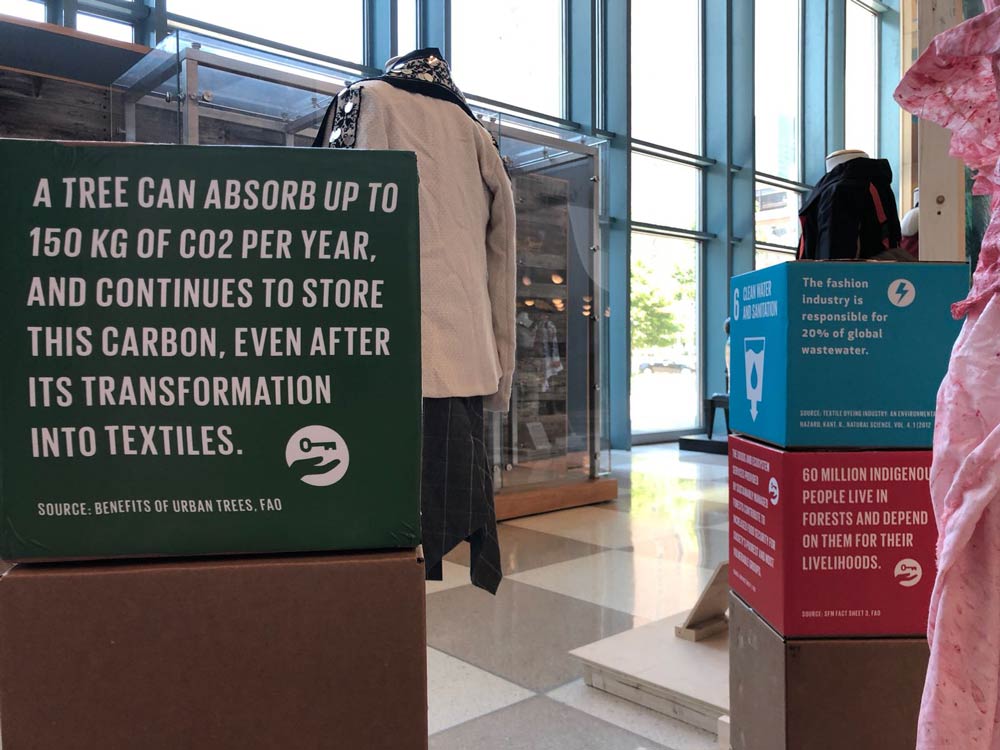
Photo Credit: Kaia Rose / Connect4Climate
Take a look at the photo album on Flickr
Despite several organizations’ initiatives, there is yet no coherent, coordinated approach taken by the United Nations to address issues related to the fashion industry. In order to change this, stakeholders from different UN organizations, civil society, and industry gathered at the panel event “Fashion and the SDGs: what role for the UN?,”which was organized in the context of the Regional Forum on Sustainable Development in the UNECE region. Stakeholders discussed how the UN could reach a more comprehensive approach toward the development of a sustainable fashion industry in order to contribute to the achievement of the SDGs. Since most high-consuming countries are located in the UNECE region, the forum was considered as a good starting point for further action. The event was successful in establishing a clear link between the fashion industry and the SDGs, which will be brought to the attention of the UN High-Level Political Forum, in particular through SDG 6 on clean water and sanitation, SDG 12 on sustainable consumption and production and SDG 15 on life on land.
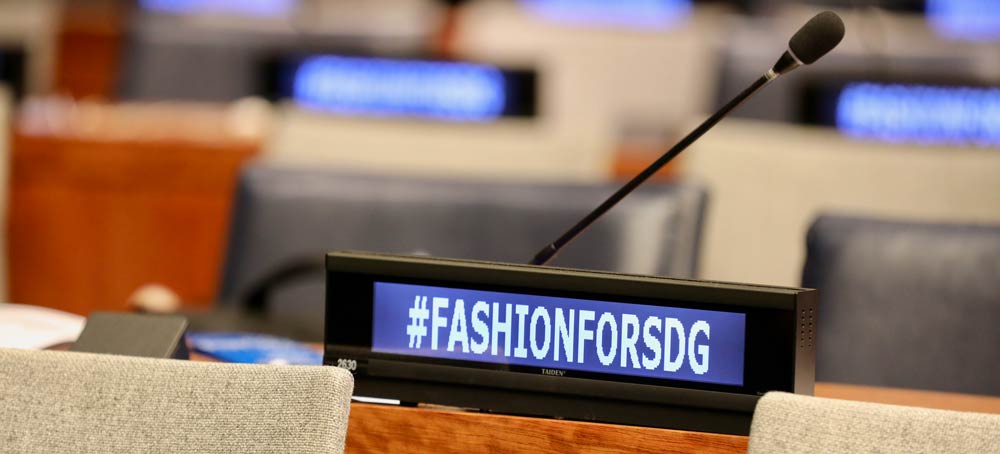
Photo Credit: Kaia Rose / Connect4Climate
Recommendations discussed prior and during the event revealed the importance of exploring the establishment of a UN Partnership on Sustainable Fashion. Indeed, it is recognized by SDG 17 that the achievement of the 2030 Agenda for Sustainable Development will require different actors working together. In order to achieve this, distinguished panelists from different UN organizations were invited to this side event to explore the elements of what a UN Partnership on Sustainable Fashion could look like.
During this side event, it was announced that UN Environment would be taking on hosting responsibilities for the first year of the Alliance. Also, the ITC has agreed to host the event in the following year.

 UN Economic Commission for Europe
UN Economic Commission for Europe

 UN Department of Economic and Social Affairs
UN Department of Economic and Social Affairs

 International Trade Centre
International Trade Centre

 UN Environment
UN Environment

 International Labour Organization
International Labour Organization

 UN Global Compact
UN Global Compact

 UN Framework Convention on Climate Change
UN Framework Convention on Climate Change

 Connect4Climate - World Bank Group
Connect4Climate - World Bank Group

 UN Office for Partnerships
UN Office for Partnerships

 UN Conference on Trade and Development
UN Conference on Trade and Development

Photo Credit: Kaia Rose / Connect4Climate
 July 10, 2018 - 1:15-2:30 PM (EDT) - Opening Remarks - Side event at High Level Political Forum, Conference Room 4
July 10, 2018 - 1:15-2:30 PM (EDT) - Opening Remarks - Side event at High Level Political Forum, Conference Room 4

 H.E. Marie Chatardová, President of ECOSOC
H.E. Marie Chatardová, President of ECOSOC

 Ms. Olga Algayerova, Executive-Secretary, UNECE
Ms. Olga Algayerova, Executive-Secretary, UNECE

 Keynote speeches
Keynote speeches

 Mr. Paolo Naldini, Director, Cittadellarte, Fashion B.E.S.T.
Mr. Paolo Naldini, Director, Cittadellarte, Fashion B.E.S.T.

 Ms. Laura Choi, President, Fashion for Conservation
Ms. Laura Choi, President, Fashion for Conservation

 Ms. Ava J. Holmes, Co-Founder, Fashion for Conservation
Ms. Ava J. Holmes, Co-Founder, Fashion for Conservation

 Discussion: Elements for a UN Partnership on Sustainable Fashion and how your organization can contribute
Discussion: Elements for a UN Partnership on Sustainable Fashion and how your organization can contribute

 Ms. Birgit Lia Altmann, Assistant Economic Affairs Officer, UNECE
Ms. Birgit Lia Altmann, Assistant Economic Affairs Officer, UNECE

 Ms. Amber Barth, Senior Program Officer, ILO Office for the United Nations in New York
Ms. Amber Barth, Senior Program Officer, ILO Office for the United Nations in New York

 Ms. Chloé Mukai, Project and Communications Manager, Ethical Fashion Initiative, ITC
Ms. Chloé Mukai, Project and Communications Manager, Ethical Fashion Initiative, ITC

 Ms. Elisa Tonda, Head, Consumption and Production Unit, UN Environment
Ms. Elisa Tonda, Head, Consumption and Production Unit, UN Environment

 Ms. Lindita Xhaferi-Salihu, Global Climate Action Outreach Office, UNFCCC
Ms. Lindita Xhaferi-Salihu, Global Climate Action Outreach Office, UNFCCC

 Ms. Lilian Liu, Manager of Partnerships, UN Global Compact
Ms. Lilian Liu, Manager of Partnerships, UN Global Compact

 Mr. Ola Goransson, Partnerships Coordinator, Divisions for Sustainable Development Goals, UNDESA
Mr. Ola Goransson, Partnerships Coordinator, Divisions for Sustainable Development Goals, UNDESA

 Mr. Francis James Dobbs, Senior Advisor, Connect4Climate, Global Engagement and Partnerships, World Bank Group
Mr. Francis James Dobbs, Senior Advisor, Connect4Climate, Global Engagement and Partnerships, World Bank Group

 Ms. Karen Newman, Expert, United Nations
Ms. Karen Newman, Expert, United Nations

 Ms. Teresa Moreira, Head of Competition and Consumer Policies Branch, UNCTAD (presented by Ms. Leonie Meier, UNECE)
Ms. Teresa Moreira, Head of Competition and Consumer Policies Branch, UNCTAD (presented by Ms. Leonie Meier, UNECE)

 Conclusions and next steps
Conclusions and next steps

 Ms. Monika Linn, Principal Advisor and Chief, Sustainable Development and Gender Unit, UNECE
Ms. Monika Linn, Principal Advisor and Chief, Sustainable Development and Gender Unit, UNECE
Pirowave - Unzipping plastic waste with portable microwave machines
About Pitch Hub Innovate4Climate 2018:
The Pitch Hub provided a dynamic space to "pitch" to potential investors and seek feedback from leaders in climate investment, finance, and markets.
Carbon Delta – the Environmental Fintech
About Pitch Hub Innovate4Climate 2018:
The Pitch Hub provided a dynamic space to "pitch" to potential investors and seek feedback from leaders in climate investment, finance, and markets.
A comprehensive annual overview of the state of renewable energy.
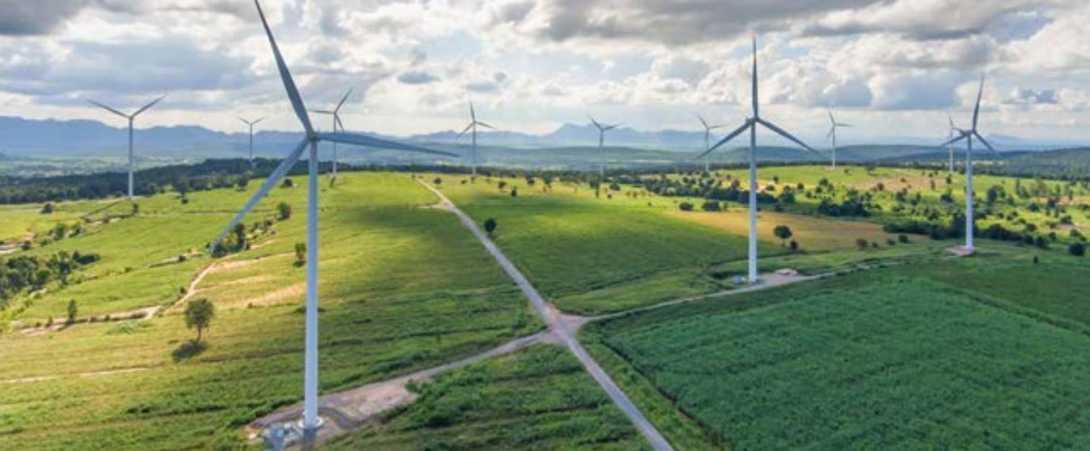
Renewable power accounted for 70% of net additions to global power generating capacity in 2017, the largest increase in renewable power capacity in modern history, according to REN21’s Renewables 2018 Global Status Report (GSR). But the heating, cooling and transport sectors – which together account for about four-fifths of global final energy demand – continue to lag far behind the power sector. The GSR, published today, is the most comprehensive annual overview of the state of renewable energy worldwide.
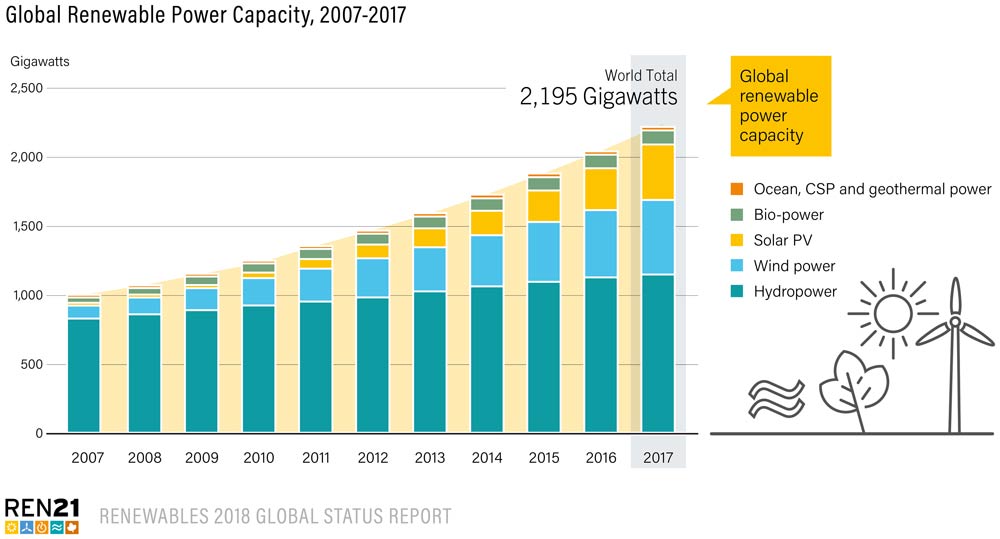
New solar photovoltaic (PV) capacity reached record levels: Solar PV additions were up 29% relative to 2016, to 98 GW. More solar PV generating capacity was added to the electricity system than net capacity additions of coal, natural gas and nuclear power combined. Wind power also drove the uptake of renewables with 52 GW added globally.
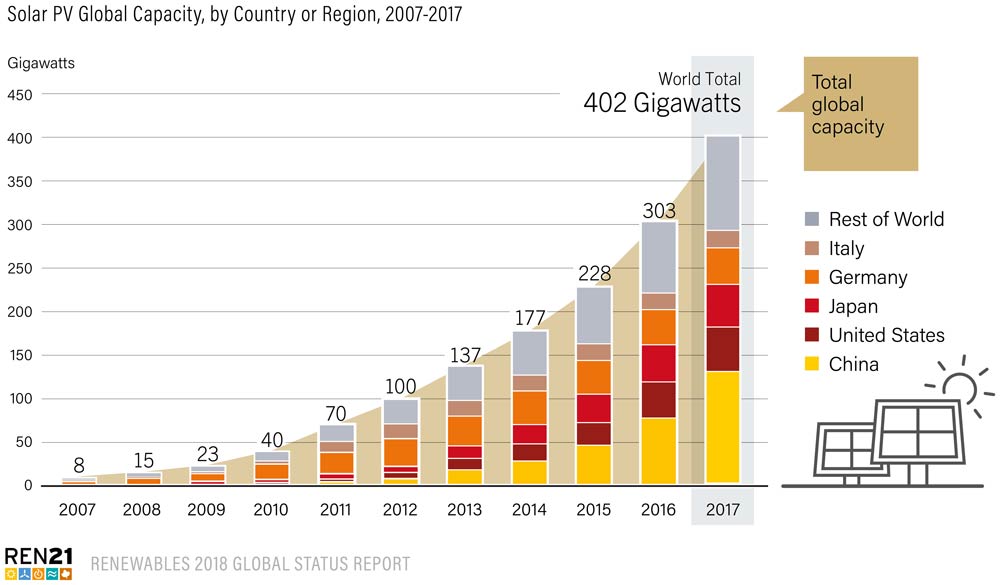
Investment in new renewable power capacity was more than twice that of net, new fossil fuel and nuclear power capacity combined, despite large, ongoing subsidies for fossil fuel generation. More than two-thirds of investments in power generation were in renewables in 2017, thanks to their increasing cost-competitiveness – and the share of renewables in the power sector is expected to only continue to rise.
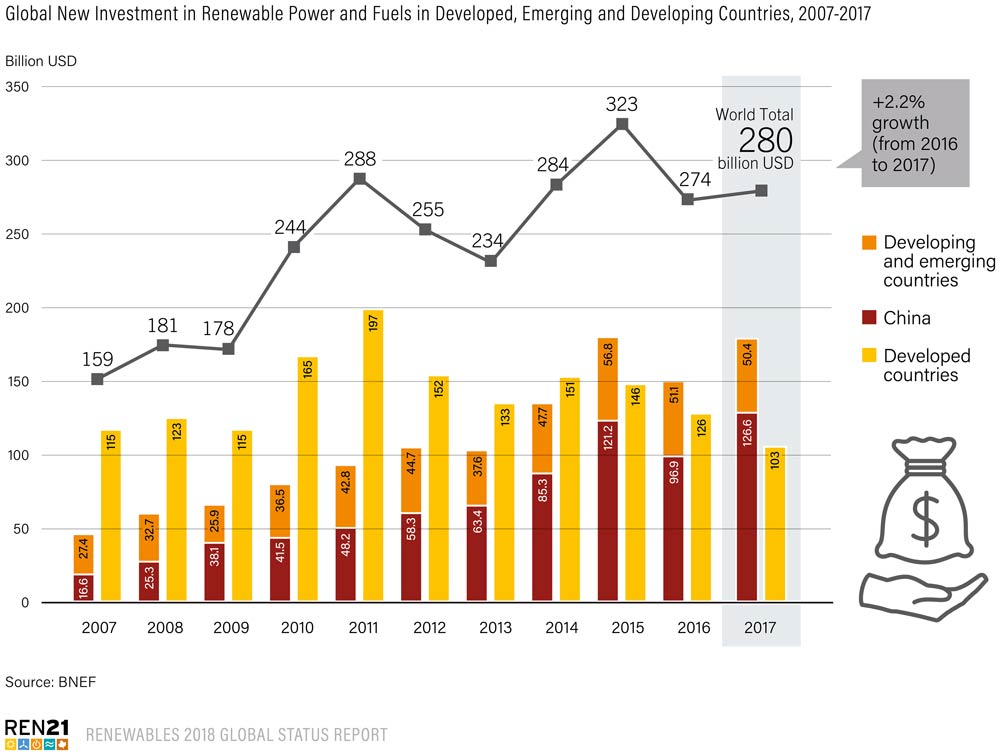
Investment in renewables was regionally concentrated: China, Europe and the United States accounted for nearly 75% of global investment in renewables in 2017. However, when measured per unit of gross domestic product (GDP), the Marshall Islands, Rwanda, the Solomon Islands, Guinea-Bissau, and many other developing countries are investing as much as or more in renewables than developed and emerging economies.
Both energy demand and energy-related CO2 emissions rose substantially for the first time in four years. Energy-related CO2 emissions rose by 1.4%. Global energy demand increased an estimated 2.1% in 2017 due to economic growth in emerging economies as well as population growth. Renewable energy uptake is not keeping pace with this increasing energy demand and the continuous investment in fossil and nuclear capacity.
In the power sector, the transition to renewables is under way but is progressing more slowly than is possible or desirable. A commitment made under the 2015 Paris climate agreement to limit global temperature rise to “well below” 2 degrees Celsius above pre-industrial levels makes the nature of the challenge much clearer.
If the world is to achieve the target set in the Paris agreement, then heating, cooling and transport will need to follow the same path as the power sector – and fast. These sectors have seen:
Little change in renewables uptake in heating and cooling: Modern renewable energy supplied approximately 10% of total global heat production in 2015. National targets for renewable energy in heating and cooling exist in only 48 countries around the world, whereas 146 countries have targets for renewable energy in the power sector.
Small changes are under way. In India, for example, installations of solar thermal collectors rose approximately 25% in 2017 as compared to 2016. China aims to have 2% of the cooling loads of its buildings come from solar thermal energy by 2020.
In transport, increasing electrification is offering possibilities for renewable energy uptake despite the dominance of fossil fuels: More than 30 million two- and three-wheeled electric vehicles are being added to the world’s roads every year, and 1.2 million passenger electric cars were sold in 2017, up about 58% from 2016. Electricity provides 1.3% of transport energy needs, of which about one-quarter is renewable, and biofuels provide 2.9%. Overall, however, 92% of transport energy demand continues to be met by oil, and only 42 countries have national targets for the use of renewable energy in transport.
For these sectors to change, the right policy frameworks need to be put in place, driving innovation and the development of new renewable energy technologies in the sectors that are lagging.

“Equating ‘electricity’ with ‘energy’ is leading to complacency. We may be racing down the pathway towards a 100% renewable electricity future, but when it comes to heating, cooling and transport, we are coasting along as if we had all the time in the world. Sadly, we don’t.”

Rana Adib, Executive Secretary of REN21

“To make the energy transition happen there needs to be political leadership by governments – for example by ending subsidies for fossil fuels and nuclear, investing in the necessary infrastructure, and establishing hard targets and policy for heating, cooling and transport. Without this leadership, it will be difficult for the world to meet climate or sustainable development commitments.”

Arthouros Zervos, REN21 Chair
Five years after its first engagement with the design industry the World Bank Group’s Connect4Climate global partnership program returns to Milan Design Week 2018 to highlight positive solutions.
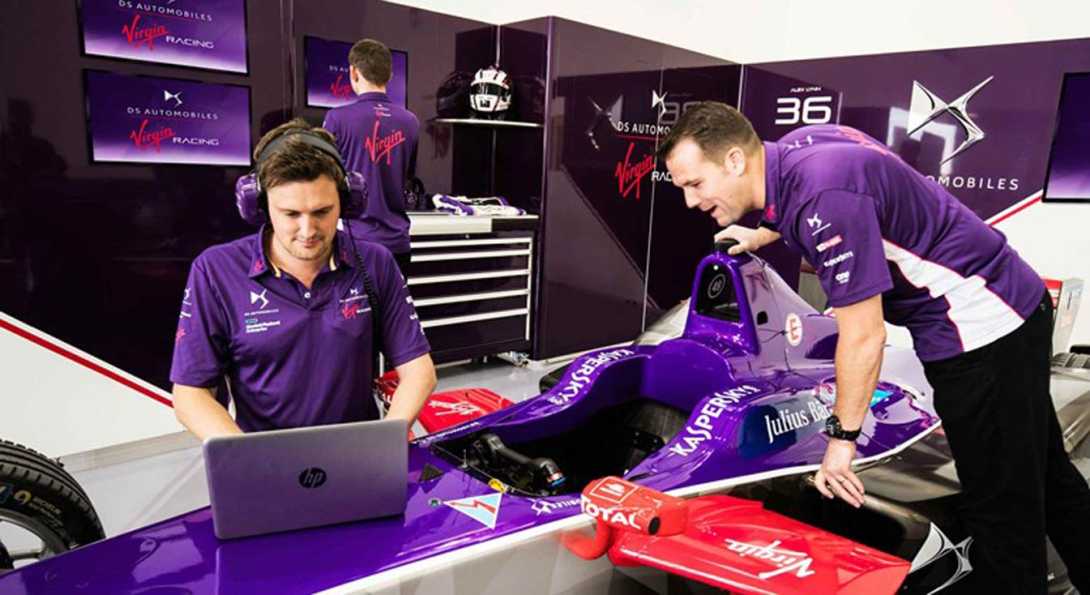




Hosted by the World Bank Group and supported by Italy’s Ministry of the Environment and Energy Security and Germany’s Federal Ministry for Economic Cooperation and Development, Connect4Climate (C4C) is a global partnership for a livable planet that connects, creates, and communicates to build long-lasting change for future generations.